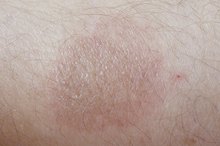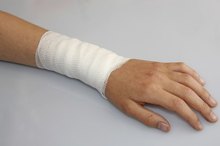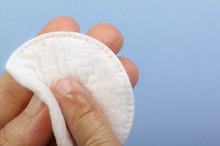Types of Dressings for Burn Wounds
Burns range in severity, depending on the amount of area they cover on the body and how deeply they penetrate through the skin and tissues beneath. They also result from various causes -- heat, friction and chemical. Since so many types of burns exist, a wide variety of burn dressings are available in modern medicine, all of which are designed to protect damaged tissue, help a burn wound heal properly and reduce your risk of infection.
Gauze and Fabric Dressing
Dressings made of gauze and fabric are essential to protect nearly every degree of burn wound. Gauze dressings are designed to wrap around an inner layer of moist dressing to keep it in place over the wound while still allowing you to move. Ace bandage is another type of elastic, fabric wrap that can help reduce swelling in the affected area.
Adherent Dressing
How to Treat a Kitchen Burn
Learn More
Certain burn dressings are designed to adhere to a treated area. A low-adherent silicone-coated synthetic mesh can be removed without difficulty from the burn site. More adherent elastic dressings may be used to cover burn wounds in the extremities, such as hands, arms and legs. These dressings are often applied over other layers.
Antibacterial, Antimicrobial Dressings
Burn dressings that keep the wounded area moist and bacteria-free are crucial to the healing process. A silver absorbent dressing may be placed over a burn wound to pull fluid that drains from the site. As this occurs, this dressing transforms into a gel that protects the burn wound from bacteria as it hardens. Antimicrobial dressings made of soft silicone can also be used, releasing silver into the wound for up to seven days. These types of burn dressings are typically covered with a gauze, fabric or adherent to keep them in place.
Emergency Dressings
How to Treat a Rug Burn
Learn More
Emergency medical services use types of burn dressings designed to be the first line in burn treatment while they are transporting someone who has suffered a severe burn to a hospital. Water gel dressings are coated with gel, and protect a burn by sealing it off from air and bacteria until nurses can properly treat the wound at the hospital. Burn towels cover the wounded area to offer protection against airborne pathogens, while burn sheets cover someone who has suffered a serious burn injury, preventing loss of vital body heat from burn wounds. Emergency workers often use saline solution, which replaces fluid lost from burn wounds, in conjunction with these sheets.
Related Articles
References
Writer Bio
A speech-language pathologist, Charlie Osborne has published articles related to his field. He was an associate editor and then editor for the American Speech-Language-Hearing Association Division 4 Perspectives in Fluency and Fluency Disorders. Osborne has a Master of Arts degree in communicative disorders from the University of Central Florida.







